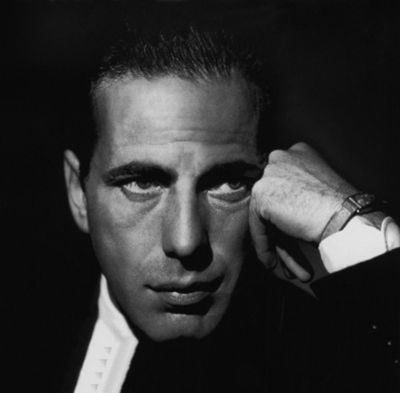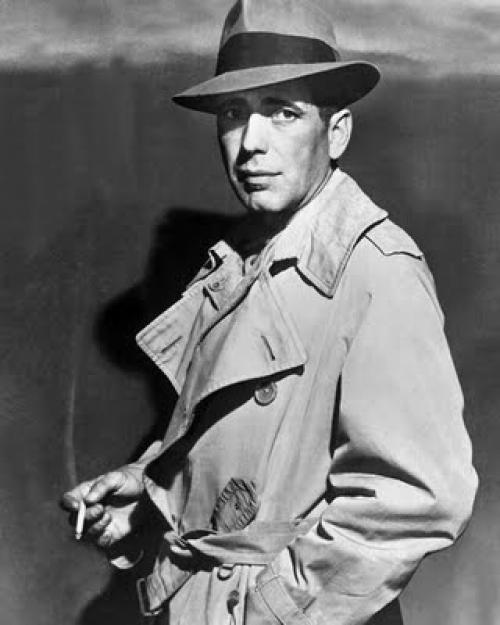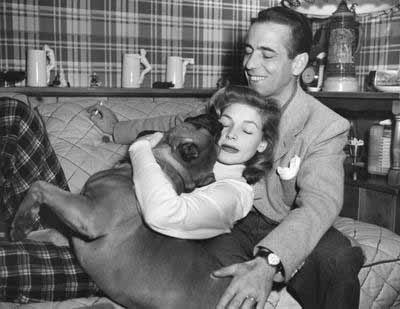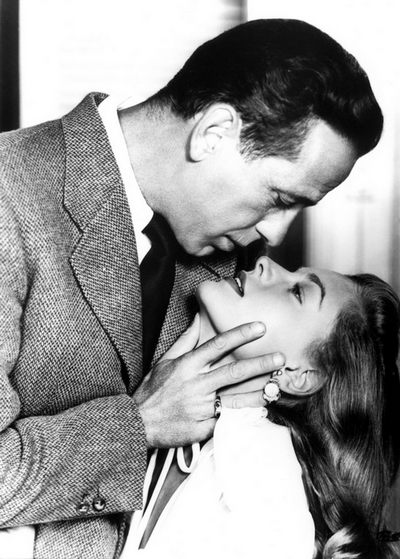By Film Noir Blonde and Mike Wilmington
The Noir File is FNB’s guide to classic film noir, neo-noir and pre-noir from the schedule of Turner Classic Movies (TCM), which broadcasts them uncut and uninterrupted. The times are Eastern Standard and (Pacific Standard).
PICK OF THE WEEK: HUMPHREY BOGART DAY (Thursday, Aug. 1)
If there is a country of film noir, then Humphrey Bogart is its president, its first citizen, its uncrowned king – a man of one unforgettable face and of many standout roles. Bogie was Philip Marlowe and Sam Spade, two ace detectives. He was Roy Earle and Duke Mantee, outlaws on the run.
He played gang leaders (“The Roaring Twenties”) and their prosecutors (“Marked Woman,” “The Enforcer”), a treasure hunter (in “Sierra Madre”) and a bad-tempered screenwriter (“In a Lonely Place”). Outside the land of noir, he was sloppy steamboat Captain Charlie Allnut in “The African Queen” and mad Captain Queeg of “The Caine Mutiny.”
Perhaps most famously he was Rick Blaine of “Casablanca,” the melancholy, sexy night club owner, no stranger to secrets, cynicism and, ultimately, sacrifice for the greater good.

Bogart’s career was sluggish at the start; he owed his big break to Leslie Howard. They starred, with Bette Davis, in “The Petrified Forest.”
As he walked the dark, rainy streets of noir, he often wore a raincoat and fedora, with a cigarette curling smoke past his grimacing, partly paralyzed lip (the result of a fight when he was in the Navy) and likely carrying a gun. His eyes were dark and sad, his voice was low and hard-edged. There was usually a snarl in that voice.
Bogart was born into a comfortable Manhattan home, the son of a surgeon and an artist. In 1918, Bogart joined the Navy, after which he went into theater and film. One of his first movies was a prison baseball comedy called “Up the River,” directed by John Ford and starring, also in one of his first movie roles, Spencer Tracy. (Ford later called the picture “one of my mortal sins.”)
Bogart’s big break came in “The Petrified Forest” (1936, Archie Mayo). Co-star Leslie Howard insisted Bogie be cast as gangster Duke Mantee (they previously starred in the play’s Broadway run). Bogie quickly became a Warner Brothers contract player fixture. He started off as mostly a villain, then an anti-hero, then finally mostly a hero.
Howard Hawks once labeled Bogie as probably the most insolent guy in movies. Then Hawks told Bogart he was going to put him in a movie with a young actress even more insolent: Lauren Bacall. Hawks directed them in 1944’s “To Have and Have Not” and they fell in love. Like Tracy and Hepburn, Bogie and Bacall became one of the great Hollywood couples – and their marriage (her first, his fourth) was the stuff that dreams are made of.
At 57, Bogart died of throat cancer from too many of those signature cigarettes of his. Speaking at the funeral, John Huston, his favorite and most sympatico director, said: “We shall not look upon his like again.”
When Bogart won his Oscar for “The African Queen” – beating out Marlon Brando in “A Streetcar Named Desire” and Montgomery Clift in “A Place in the Sun,” two of the most influential movie performances of the ’50s – he explained, “I’ve been around for a long time. Maybe the people like me.”
They do like him, still. Nobody wore a raincoat, cracked wise to a crook or a cop, or walked down a mean noir street, like Bogie. Nobody ever will. Here’s looking at you, kid.
(Note: Most of the following titles have been reviewed on FNB. Use the search tool on the right to find them.)
6 a.m. (3 a.m.): “Bogart: The Untold Story” (1996). A documentary look at Bogie’s life in (and out) of movies, hosted by his son, Stephen Bogart.
7 a.m. (4 a.m.): “High Sierra” (1941, Raoul Walsh).
9 a.m. (6 a.m.): “The Maltese Falcon” (1941, John Huston).
10:45 a.m. (7:45 a.m.). “To Have and Have Not“ (1944, Howard Hawks).
12:30 p.m. (9:30 a.m.): “The Treasure of the Sierra Madre” (1948, John Huston).
2:45 p.m. (11:45 a.m.) “Tokyo Joe” (1949, Stuart Heisler).
4:15 p.m. (1:15 p.m.). “Beat the Devil” (1954, John Huston).
6 p.m. (3 p.m.): “In a Lonely Place” (1950, Nicholas Ray).
8 p.m. (5 p.m.). “The Big Sleep” (1946, Howard Hawks).
10 p.m. (7 p.m.): “Key Largo” (1948, John Huston).
4 a.m. (1 a.m.): “The Harder They Fall” (1956, Mark Robson).
Wednesday, July 31
4:30 p.m. (1:30 p.m.): “5 Against the House” (1955, Phil Karlson). Guy Madison, Kim Novak, Brian Keith, Alvy Moore and Kerwin Mathews are four college buddies and a knockout lounge singer who get tied up in robbing a Reno casino for kicks. A smooth, fast Phil Karlson job and a good, if minor, heist thriller, with stellar psycho-villainy from Keith.
6 p.m. (3 p.m.): “Born to Kill” (1947, Robert Wise).
Saturday, Aug. 3
10:15 a.m. (7:15 a.m.): “The Lavender Hill Mob” (1951, Charles Crichton).
12 p.m. (9 a.m.): “The Ladykillers” (1955, Alexander Mackendrick). A gang of seedy misfit fitfully sinister London robbers hide out in a boarding house run by a sweet little old British lady (Katie Johnson). But when necessity demands they kill her, she proves more than a match for all of them. A dark comedy noir classic, written by William Rose. The gang, run by a snaggle-toothed Alec Guinness, includes Peter Sellers, Herbert Lom, Danny Green and Cecil Parker, and they’re a fabulously comic, evil crew. This is one of two great heist comedies and I forget the other one. (No I don‘t. It’s Mario Monicelli’s “Big Deal on Madonna Street.”)
12 a.m. (9 p.m.): “Kind Hearts and Coronets” (1949, Robert Hamer).
Tuesday, Aug. 6
9:15 a.m. (6:15 a.m.). “Born to be Bad” (1950, Nicholas Ray). With Joan Fontaine, Robert Ryan and Mel Ferrer.
12:30 p.m. (9:30 a.m.): “Beyond a Reasonable Doubt” (1956, Fritz Lang).
6 p.m. (3 p.m.): “Suspicion” (1941, Alfred Hitchcock).
8 p.m. (5 p.m.): “Rebecca” (1950, Alfred Hitchcock).













From FNB readers